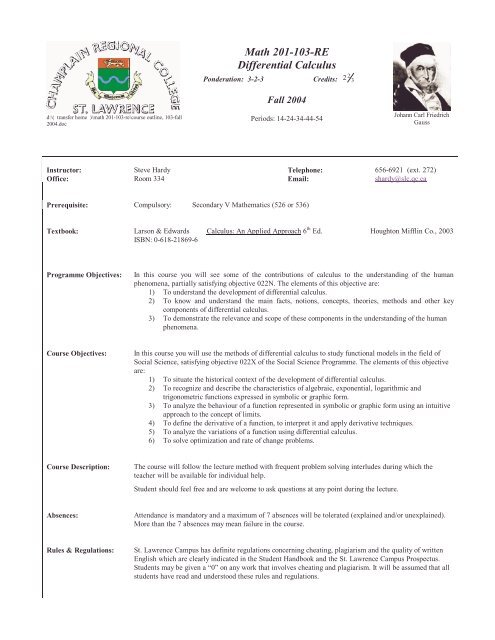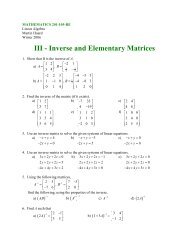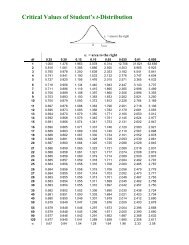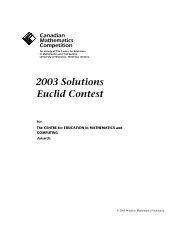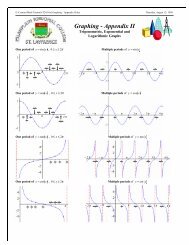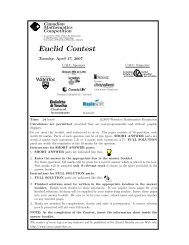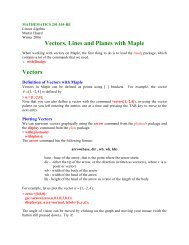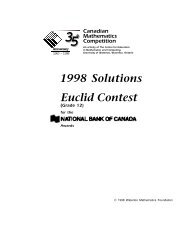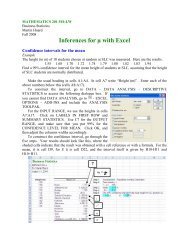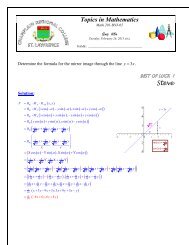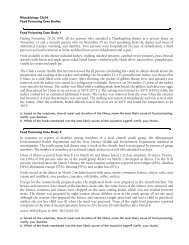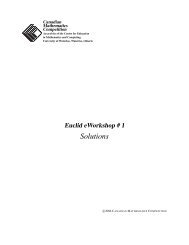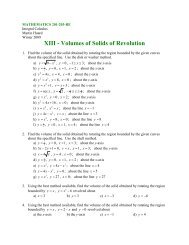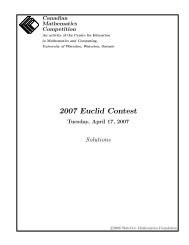Math 201-103-RE Differential Calculus - SLC Home Page
Math 201-103-RE Differential Calculus - SLC Home Page
Math 201-103-RE Differential Calculus - SLC Home Page
You also want an ePaper? Increase the reach of your titles
YUMPU automatically turns print PDFs into web optimized ePapers that Google loves.
d:\( transfer home )\math <strong>201</strong>-<strong>103</strong>-re\course outline, <strong>103</strong>-fall<br />
2004.doc<br />
<strong>Math</strong> <strong>201</strong>-<strong>103</strong>-<strong>RE</strong><br />
<strong>Differential</strong> <strong>Calculus</strong><br />
Ponderation: 3-2-3 Credits: 2 2 3<br />
Fall 2004<br />
Periods: 14-24-34-44-54<br />
Johann Carl Friedrich<br />
Gauss<br />
Instructor: Steve Hardy Telephone: 656-6921 (ext. 272)<br />
Office: Room 334 Email: shardy@slc.qc.ca<br />
Prerequisite: Compulsory: Secondary V <strong>Math</strong>ematics (526 or 536)<br />
Textbook: Larson & Edwards <strong>Calculus</strong>: An Applied Approach 6 th Ed. Houghton Mifflin Co., 2003<br />
ISBN: 0-618-21869-6<br />
Programme Objectives: In this course you will see some of the contributions of calculus to the understanding of the human<br />
phenomena, partially satisfying objective 022N. The elements of this objective are:<br />
1) To understand the development of differential calculus.<br />
2) To know and understand the main facts, notions, concepts, theories, methods and other key<br />
components of differential calculus.<br />
3) To demonstrate the relevance and scope of these components in the understanding of the human<br />
phenomena.<br />
Course Objectives: In this course you will use the methods of differential calculus to study functional models in the field of<br />
Social Science, satisfying objective 022X of the Social Science Programme. The elements of this objective<br />
are:<br />
1) To situate the historical context of the development of differential calculus.<br />
2) To recognize and describe the characteristics of algebraic, exponential, logarithmic and<br />
trigonometric functions expressed in symbolic or graphic form.<br />
3) To analyze the behaviour of a function represented in symbolic or graphic form using an intuitive<br />
approach to the concept of limits.<br />
4) To define the derivative of a function, to interpret it and apply derivative techniques.<br />
5) To analyze the variations of a function using differential calculus.<br />
6) To solve optimization and rate of change problems.<br />
Course Description: The course will follow the lecture method with frequent problem solving interludes during which the<br />
teacher will be available for individual help.<br />
Student should feel free and are welcome to ask questions at any point during the lecture.<br />
Absences: Attendance is mandatory and a maximum of 7 absences will be tolerated (explained and/or unexplained).<br />
More than the 7 absences may mean failure in the course.<br />
Rules & Regulations: St. Lawrence Campus has definite regulations concerning cheating, plagiarism and the quality of written<br />
English which are clearly indicated in the Student Handbook and the St. Lawrence Campus Prospectus.<br />
Students may be given a “0” on any work that involves cheating and plagiarism. It will be assumed that all<br />
students have read and understood these rules and regulations.
Evaluation:<br />
The evaluation of this course will verify that you have learned the following:<br />
1) To use the appropriate concepts.<br />
2) To represent situations through the use of functions.<br />
3) To sketch adequate graphic representations of functions.<br />
4) To choose and apply the correct differentiation rules and techniques.<br />
5) To manipulate algebraic expressions correctly.<br />
6) To make accurate calculations.<br />
7) To arrive at correct interpretations of results.<br />
8) To justify the steps you have taken in problem solving.<br />
9) To use the appropriate terminology (notation).<br />
The final grade will be obtained through:<br />
Gifts: Regular "Gifts" (i.e. homework) will be given. Students will be expected to submit their "Gift" the<br />
following school day in a NEAT and LEGIBLE way at the beginning of class, LATE "Gifts" will not be<br />
accepted.<br />
Quizzes: Regular (weekly, ~10 minutes) quizzes will be given during the semester on the topic(s) covered during the<br />
week. A student missing a quiz will automatically be given the result “0” for that quiz.<br />
Tests: • There will be 3 class test during the semester which are compulsory. A student missing a test will<br />
automatically be given the result “0” for that test.<br />
• Students are responsible for knowing when a test will be given. Ignorance of a test date will not be<br />
considered a valid excuse.<br />
• In the event that the college closes or the teacher is absent on a scheduled Quiz/Test date, the Quiz or<br />
Test is moved to the next school day automatically.<br />
Final Exam: There will be a three hours comprehensive final examination at the end of the semester.<br />
Grading<br />
Scheme:<br />
Course Content:<br />
The final grades will be calculated as follows:<br />
Final Grade<br />
Gifts Approximately 40 . . . . . . . . . . . 10%<br />
Quiz Approximately 10 . . . . . . . . . . . 10%<br />
Test 3 @ 15% each . . . . . . . . . . . 45%<br />
Final Exam . . . . . . . . . . . 35%<br />
0. <strong>RE</strong>VIEW:<br />
a) Factoring, Functional Notation.<br />
1. LIMITS:<br />
a) Concept of a Limit.<br />
b) Limits at Infinity.<br />
c) Secant and Tangent Lines.<br />
d) Properties of Limits and their Use.<br />
e) Concept of Continuity.<br />
2. DERIVATIVES AND DIFFE<strong>RE</strong>NTIATION:<br />
a) Concept of a Derivative.<br />
b) Properties of Derivatives.<br />
c) Differentiation Rules and Formulas.<br />
d) Rates of Changes & Related Rates.<br />
e) The Chain Rule.<br />
f) Implicit Differentiation.<br />
g) Higher Order Derivatives.<br />
h) <strong>Differential</strong>s.<br />
i) The Mean Value and Rolle’s Theorem.<br />
1 These topics will only be covered if time allows.<br />
3. DERIVATIVES OF SPECIAL FUNCTIONS:<br />
a) Derivative of Trigonometric Functions.<br />
b) Derivative of Exponential Functions.<br />
c) Derivative of Logarithmic Functions.<br />
d) Derivative of Inverse Trig. Functions.<br />
4. APPLICATIONS:<br />
a) Related Rates<br />
b) Linear Approximation using <strong>Differential</strong>s.<br />
c) Newton-Raphson’s Method. 1<br />
d) Exponential Growth and Decay.<br />
e) Optimization<br />
f) Curve Sketching.<br />
g) Indeterminate Forms and L’Hôpital’s Rule.


